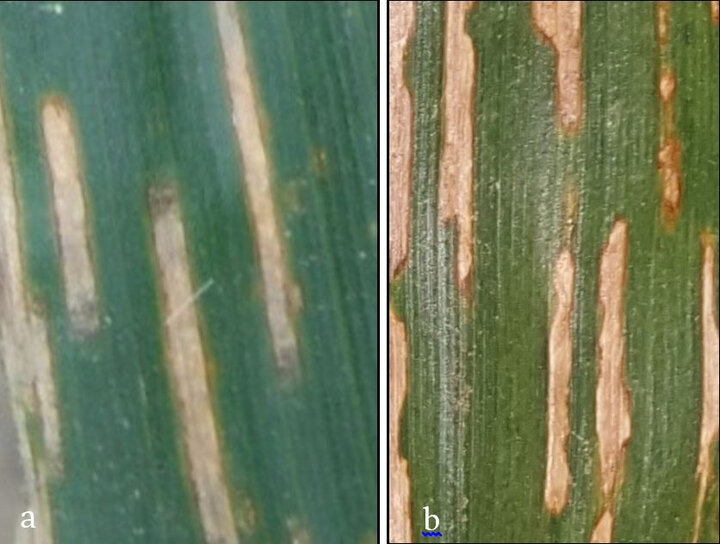Over the past couple of weeks, bacterial leaf streak (Figure 1) of corn has been on the rise as large portions of Nebraska experienced several days of cool, wet weather. Bacterial leaf streak (BLS) is caused by Xanthomonas vasicola pv. vasculorum. This bacterial disease has been confirmed in 74 Nebraska counties and in nine other states since 2016. BLS has been confirmed in field corn, sweet corn, seed corn, and popcorn.
Symptoms and Signs

Early diagnosis of BLS is important as symptoms can easily be confused with other diseases. This time of year, lesions are typically found on the lower leaves of the plant. Lesions may be brown, tan, or yellow in color and range in size from small flecks to streaks that can be several inches long. Margins are often jagged, wavy, and have a yellowish hue that is more pronounced when backlit by the sun. As plants mature, symptoms may develop in the mid-to-upper canopy along the midrib following a severe storm or heavy rain event. Symptoms can develop as early as in V4 corn, but have been confirmed in the seedling stage in greenhouse studies.
Scouting is important as BLS can easily be confused with gray leaf spot, a common fungal disease in corn (Figure 2). Compared to BLS, gray leaf spot lesions are gray and rectangular in shape with smooth, linear margins. Early symptoms can make it difficult to differentiate these two diseases. Bacterial leaf streak cannot be controlled with the fungicides used to manage fungal diseases like gray leaf spot. Accurate identification is crucial for disease management. Submit samples to a diagnostic clinic for accurate diagnosis if necessary. (The university’s Plant and Pest Diagnostic Clinic conducts these tests.)
Disease Cycle
Three things are required for any disease to develop:
- a virulent pathogen,
- a susceptible host, and
- the right environmental conditions.
Infested crop residue from a previous year’s crop is an excellent source of inoculum for BLS development. Residue can be moved into fields that do not have a history of this disease via equipment, floods, or wind. As corn grows, heavy rain or irrigation can splash bacteria onto the leaf surface. Bacteria may spread throughout the field via leaf rubbing, splashing, etc. Wounds are not required for disease development as bacteria likely enter through natural openings in leaves, like stomata. Favorable environmental conditions for disease development include high relative humidity, leaf wetness, severe storms, minimum tillage, or growing continuous corn.
Management
| Common Name ‘Variety’ | |
|---|---|
| Oat ‘Jerry’ | Timothy ‘Climax’ |
| Rice (multiple varieties) | Sand Bluestem |
| Shattercane | Green Foxtail |
| Johnsongrass | Bristly Foxtaila |
| Orchardgrass ‘Latar’ | Yellow Nutsedgeb |
| Indiangrass ‘Holt’ | Downy Bromec |
| Big Bluestema ‘Champ’ | Tall Fescuec ‘Cajun II’ |
| Little Bluestem ‘Blaze’ | Western Wheatgrassc |
aSymptomatic in field experiments We gratefully acknowledge S. Knox, P. S. Baenziger, I. Dweikat, M Sousek, K. Amundsen, A. Jhala, G. Kruger, and K. Schroeder of UNL and R. Russell (Arrow Seed Company), and Y. Wamishe (University of Arkansas) for providing seed for testing. Literature cited: |
|
Management options for BLS in corn include rotation to a non-host crop like soybean or wheat. While crop rotation can be quite effective in managing BLS, it is important to also manage volunteer corn that can harbor the bacteria from year-to-year. Recent research has shown that certain species of weeds, native grasses, and crops also can be alternative hosts for the bacterium (Table 1). In field studies, big bluestem and bristly foxtail showed symptoms of BLS at low levels. Numerous other weed, crop, and grass species were susceptible to the bacteria in greenhouse experiments and may become infected in the field under favorable conditions. Some of these alternative host species were infected without development of disease symptoms. Therefore, weed management may also be important to consider with crop rotation strategies, although the impact of these alternative host species on disease development in corn has not been determined.
Since BLS is caused by a bacterial pathogen, fungicides are not effective in managing this disease. Research on BLS management using copper-based bactericide products has been conducted, but results are inconclusive at this point. Copper-based bactericides are generally contact products that are not absorbed and moved systemically by the plant like some of the common fungicides currently in use. These bactericides do not provide residual protection and may be washed off by rain or overhead irrigation requiring reapplication that may not be economical for corn producers. In addition, these products function by preventing new infections and don’t impact bacteria already inside the plant after infection occurs.
Tillage can help break down infested crop residue and reduce inoculum levels. However, tillage may not be a viable option for every operation and it won’t completely prevent future disease development. Sanitation is another option. Cleaning off equipment between fields will help slow pathogen spread to new areas. Hybrids vary in their reaction to the disease, although disease ratings are difficult to generate and not widely available. Consult seed company representatives to help identify the hybrids best suited for your area. More information on bacterial leaf streak in corn is available in this Nebraska Extension resource.

